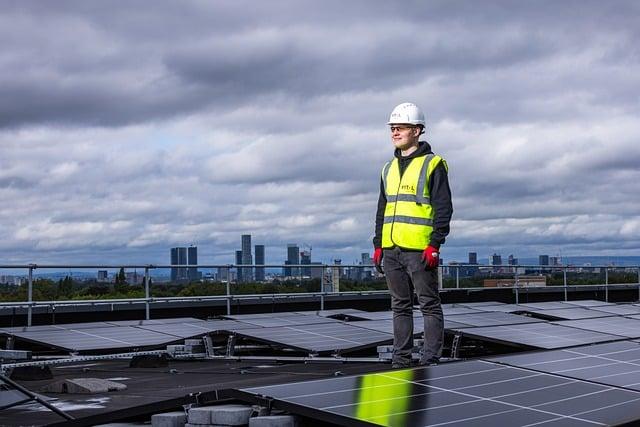In the wake of nature’s unpredictable fury, when the winds howl and the earth trembles, the resilience of human spirit often finds its strongest ally in innovation. Amidst the chaos of disaster-stricken landscapes, where conventional power lines lie tangled and lifeless, a silent revolution is unfolding. Solar energy, with its promise of clean, renewable power, is emerging as a beacon of hope and efficiency in disaster relief efforts. This article delves into the transformative role of solar technology, exploring how it is seamlessly integrated into emergency response strategies to illuminate the darkest of times, powering everything from communication devices to field hospitals, and paving a sustainable path to recovery. Join us as we journey through the stories of ingenuity and perseverance that showcase the profound impact of harnessing the sun’s energy when it is needed the most.
Harnessing the Sun: Innovative Approaches to Solar Energy in Crisis Zones
In recent years, solar energy has emerged as a beacon of hope in the chaos of disaster-stricken regions. Portable solar panels and solar-powered water purification systems are at the forefront of innovative solutions, transforming how aid is delivered. By harnessing the power of the sun, relief efforts are becoming more sustainable and efficient, ensuring that communities can recover and rebuild with minimal environmental impact.
Relief organizations are adopting a variety of solar technologies to tackle the immediate challenges faced in crisis zones. These include:
- Solar-powered communication hubs: Facilitating critical communication by powering essential devices and enabling connectivity in isolated areas.
- Solar lanterns and chargers: Providing light and power to charge mobile devices, essential for maintaining contact with loved ones and coordinating relief efforts.
- Mobile solar units: Easily transportable and quick to set up, offering a reliable energy source for medical tents and field kitchens.
These innovative applications underscore the pivotal role solar energy plays in modern humanitarian strategies, delivering not only immediate relief but also paving the way for long-term resilience.

Empowering Resilience: How Solar Solutions Enhance Emergency Response
In the face of natural disasters, the integration of solar energy into emergency response strategies has emerged as a beacon of hope, providing reliable and sustainable power solutions when traditional infrastructure falters. Solar technologies offer a versatile and immediate energy source that can be deployed swiftly in affected areas, ensuring that critical operations, from medical facilities to communication networks, remain operational. The adaptability of solar systems allows for quick installation on-site, transforming barren landscapes into hubs of energy, which can be pivotal in saving lives and maintaining order.
- Portability: Solar panels can be transported and set up in remote locations with ease, offering instant power without the need for extensive grid connections.
- Scalability: Systems can be scaled to meet varying energy demands, from powering small devices to sustaining larger facilities.
- Sustainability: By utilizing renewable energy, solar solutions reduce the dependency on fossil fuels, minimizing environmental impact during recovery efforts.
Moreover, solar-powered solutions not only address immediate needs but also pave the way for long-term resilience. They provide communities with the tools to rebuild with a focus on sustainability, ensuring that energy access is not just a temporary fix but a lasting improvement. As climate change continues to exacerbate the frequency and severity of disasters, the role of solar energy in emergency response becomes increasingly crucial, offering a glimmer of stability in the most chaotic of circumstances.

From Blackouts to Bright Skies: Solar Energys Role in Disaster Recovery
In the aftermath of natural disasters, when traditional power infrastructures are often compromised, solar energy emerges as a beacon of hope. The integration of solar power into disaster relief efforts provides a sustainable and reliable energy source, critical for powering emergency shelters, hospitals, and communication systems. Solar panels, with their ability to function independently of the grid, can be rapidly deployed to affected areas, offering immediate relief. This swift deployment is facilitated by their modular nature, allowing for scalability depending on the needs of the crisis.
- Mobility: Portable solar kits can be transported easily to remote or hard-hit locations.
- Durability: Designed to withstand harsh weather conditions, ensuring longevity and reliability.
- Sustainability: Reduces dependency on fossil fuels, cutting down on emissions even in disaster scenarios.
These attributes not only support immediate recovery efforts but also pave the way for long-term resilience. By investing in solar infrastructure as part of disaster preparedness, communities can fortify themselves against future disruptions, ensuring that from the shadows of blackouts, bright skies emerge as a testament to human ingenuity and resilience.

Strategic Implementation: Best Practices for Solar Deployment in Relief Efforts
In disaster relief scenarios, the integration of solar energy solutions requires meticulous planning and execution. A key best practice involves conducting a thorough assessment of the site to understand the geographical and logistical challenges. This includes evaluating the solar potential of the area, considering factors like sunlight availability and weather patterns. Collaborating with local authorities and communities can provide valuable insights and enhance the effectiveness of the deployment. Furthermore, it’s crucial to tailor the solar solutions to the specific needs of the relief efforts, ensuring they are scalable and adaptable to evolving situations.
Successful solar deployment in these contexts also hinges on the establishment of a robust supply chain. Ensuring the availability of solar panels, batteries, and other essential components is vital for seamless operation. It is beneficial to create a rapid response team trained in solar installation and maintenance to address technical issues swiftly. Additionally, prioritizing the use of portable and modular systems can significantly enhance mobility and ease of installation in challenging terrains. Emphasizing these strategic elements can lead to a more resilient and sustainable disaster relief infrastructure powered by solar energy.
Future Outlook
As the sun dips below the horizon, casting a gentle glow over the horizon, we are reminded of the boundless potential that solar energy holds in our ever-evolving world. In the face of disasters, where the shadows of uncertainty loom large, solar energy emerges as a beacon of hope and resilience. By harnessing the power of the sun, communities can illuminate their paths to recovery, transforming adversity into opportunity. As we continue to integrate solar solutions into disaster relief efforts, we pave the way for a future where light conquers darkness, and innovation stands as a testament to human ingenuity. The journey is ongoing, and with each step, we edge closer to a world where solar energy not only powers our homes but also our hopes, lighting the way through the storm.

































